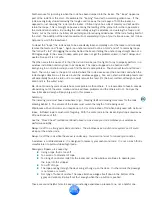
20
Windlass
FactAndFiction
Windlasses are often times viewed as the culprit whenever there has been a problem with the
anchoring system. All vertical and horizontal windlasses must have the same installation opportunity
to function as the manufacturer has intended for it to work. Unfortunately vessel manufacturers and
designers have space constraints that may cut into the perception that the consumer has regarding
the level of performance that is delivered from the system. The following information will answer
some of the myths and facts regarding anchoring systems.
All windlasses, no matter the manufacturer, must have a minimum amount of fall directly under the
windlass to accept the anchor rode paying off the gypsy, down into the anchor locker. The windlass
does not "stow" the rode into the anchor locker. Gravity and locker capacity play the major role in
capturing the rode and "stowing" the rode until it is needed to hold the boat during the anchoring
process. The conventional windlass installation/operation will work best when the windlass is sitting
over the widest and deepest portion of the locker. This will help gravity to stow the rode evenly as it
pays off the windlass. The locker layout does play a part in how well the rode will pay off the
windlass, as well.
The anchor rode must have available space in the locker. The incoming rode must leave the area
where the rode pays off the windlasses gypsy free and clear to keep it from piling up in front of the
windlass. Should there not be sufficient free space, the operator will have to "tend" the rode so that
there is space for the rode as it pays off the gypsy. If the rode is not tended to it will "pile up" on
itself directly in front of the windlass or underneath the mounting platform. Creating a "bottle neck",
jamming the rode as it is trying to pay off the gypsy. This will, of course, "trip" the circuit breaker
and damage the stripper. No matter what the rode length is, there must be free space for the rode
paying off the gypsy into the locker or in front of the windlass to allow for the oncoming rode, the
windlass cannot detect that the locker is full.
Whenever you alter your anchor rode, adding a longer tail scope of chain or ALL chain rode you
must be sure the extra length or size change will be adequate for the windlass that is installed. Just
because you can physically put a given length of rode into a locker does not mean that the windlass
will do the same. The trade off point is the windlass will do all of the "back breaking" work for you.
Simple rules to cross check your rode choice is to find the total weight of your rope, chain and
anchor. Multiply the total rode weight by 3. If your findings are less than the maximum pulling power
of the windlass you then have selected a rode that is matched to the capacity of the windlass.
Should you find that the total rode weight multiplied by 3 is greater than the maximum pulling power
of the windlass, you will have to replace the windlass as it will not provide you with the service you
are looking for. This method is telling you that the system is now mismatched. (You will find the max
pulling power information listed in your owner’s manual.)
A common problem discussed alot is rode jamming. Some of the reports refer to a "looping" in the
line that creates a jamming of the rode from underneath as the rode pays out. It is believed that a
common anchor swivel may prevent the "looping" of the anchor rode. Looping is a common action
that is part of the line falling over on itself as the line pays into the anchor locker. The line will rotate
clockwise during the recovery process, hesitate and then fall over itself and continue to rotate
counter clockwise until the rope repeats the hesitation; at which time the rope falls again over itself
as it lays in the locker. The "loops" are created when the rope changes direction as it pays into the
locker. The anchor swivel will not stop this action. The "looping" is increased when the lay of the 3-
strand nylon rope becomes tighter, or after it has been used in salt water over a period of time.
Saline builds up in the rope fibers over time and causes the rope to stiffen. However, a good fabric
softener rinse has been found to be very effective in lessening this problem. Depending on where
you cruise will determine the effect the salt water has on your rope. It has been found that some
fresh water lakes will "soften" the rope and cause it to jam.
Содержание HUNTER 25
Страница 54: ...Recommendations made by manufacturers of original equipment for proper maintenance and up keep PAGE 13A 10...
Страница 55: ...Power Squadron recommendations for maintenance and safe boating PAGE 13A 11...
Страница 56: ...Local sailing club or marina s recommendations for maintenance and up keep PAGE 13A 12...
Страница 57: ...List of onboard safety equipment and location A copy should be posted onboard at all times PAGE 13A 13...
Страница 58: ...Spare parts list PAGE 13A 14...
Страница 59: ...Dates of practice drills and onboard safety inspections PAGE 13A 15...
Страница 60: ...MY PERSONAL PREFERENCES FOR MAINTENANCE ITEMS SAFETY GEAR PAGE 13A 16...
Страница 68: ......
Страница 76: ......
Страница 86: ......
Страница 97: ......
Страница 98: ......
Страница 99: ......
Страница 101: ......
Страница 103: ......
Страница 104: ......
Страница 105: ......
Страница 106: ......
Страница 107: ......
Страница 108: ......
Страница 109: ......
Страница 110: ......
Страница 114: ......
Страница 115: ......
Страница 116: ......
Страница 118: ......
Страница 119: ......
Страница 120: ......
Страница 121: ......
Страница 122: ......
Страница 123: ......
Страница 124: ......
Страница 125: ......
Страница 126: ......
Страница 127: ......
Страница 128: ......
















































